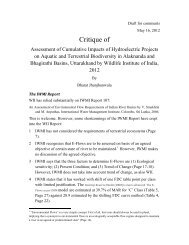Proposed Power Development Plan (PDP) 2012 - Palang Thai
Proposed Power Development Plan (PDP) 2012 - Palang Thai
Proposed Power Development Plan (PDP) 2012 - Palang Thai
- No tags were found...
Create successful ePaper yourself
Turn your PDF publications into a flip-book with our unique Google optimized e-Paper software.
<strong>Proposed</strong> <strong>Power</strong> <strong>Development</strong> <strong>Plan</strong> (<strong>PDP</strong>) <strong>2012</strong>and a Framework for Improving Accountability and Performance of <strong>Power</strong> Sector <strong>Plan</strong>ningElectricity demand projectionThe foundation for the <strong>PDP</strong> is an official forecast of future electricity consumption. Because electricity cannot becost-effectively stored at national-scales, supply must be balanced with demand at every moment. Thus, theforecasted peak demand figure is important because the peak demand (plus the agreed-upon reserve margin),determines the amount of power plants that are necessary to ensure adequate power supply in the country.Because power plants and other related investments have long lead-times (typical large thermal plant requires twoto three years of construction time, a typical hydropower plant requires at least four, and nuclear power plants atleast five not including licensing and approval 2 ), planning ahead is necessary to avoid power shortages. However,inaccurate forecasts could also lead to either a shortage situation (too few power plants built) or surplus situation(too many power plants built). Each has significant economic ramifications. As described below, <strong>Thai</strong>land loadforecasts have consistently led to expensive power plant surpluses.The <strong>Thai</strong> Load Forecast Subcommittee 3 , under the Ministry of Energy, makes projections of the country’s futureelectricity demand and updates them approximately every two years, or when circumstances change.The key features of the methodology used to forecast demand are as follows:• demand projections are primarily based on medium and long-term GDP growth forecasts (Vernstrom 2005).• A secondary source of information comprises end-use models for certain customer classes with sufficientavailable data (residential, and some commercial and industrial customer classes).• the fundamental underlying concept is one of exponential growth (annual increases are higher as the base(total consumption) increases).Figure 1 show the actual peak demand in <strong>Thai</strong>land (solid red line) compared to every forecast used to developgovernment power development plans over the past 20 years. There is a clear systemic tendency to over-estimateactual demand for electricity.Figure 1: Government’s load forecasts made in previous years of peak electricity demand (in MW) are allconsiderably higher than actual demand (solid red line at bottom of graph).2According to the French Nuclear Safety Authority (ASN), it takes at least fi ve years to set up the legal and regulatory infrastructurefor a nuclear power program, two to ten years to license a new plant, and about fi ve years to build a power plant. That meansa “minimum lead time of 15 years” before a new nuclear power plant can be started up in a country that does not already havethe required infrastructure. Source: http://www.world-nuclear.org/info/inf102.html, accessed March 21, <strong>2012</strong>.3Chaired by Energy Permanent Secretary, the Load Forecast Subcommittee comprises mainly representatives from the three electricutilities, government agencies, large power users and a few academics.10
















